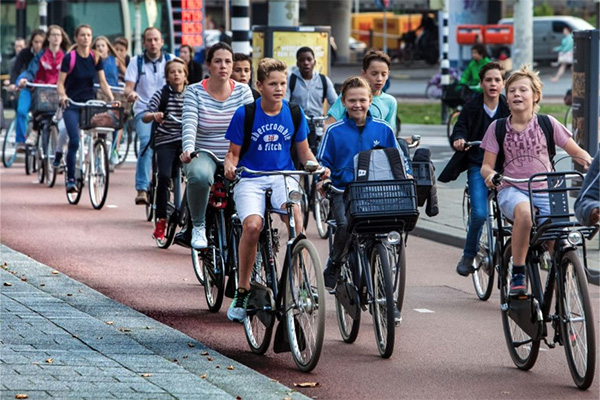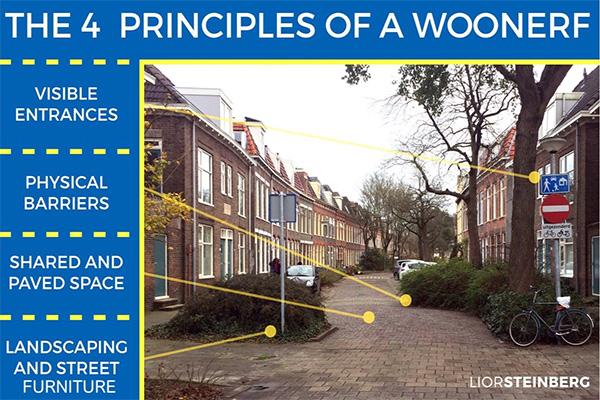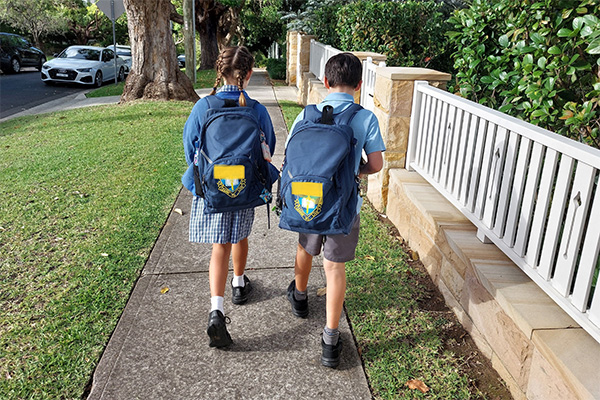Nicolle Kuppens is an urban planner who lives on Sydney’s lower north shore and loves riding bikes. Two years ago, Nicolle and her young family moved back to Australia after a decade in the Netherlands. And she is really missing the ease of getting around by bike!
When cycling is part of the fabric of daily life
When I moved to the Netherlands at the end of my twenties, I did not anticipate how quickly I would fall for Dutch cycling culture. In the Netherlands, cycling is for everyone: from uni students on bikes which look like they will fall to pieces any minute, right through to elderly ladies with sheepskin bike seat covers.
And yes, cycling was also for me, a foreigner, wobbling along at a snail’s pace!
While cycling does not account for a large share of the kilometres travelled in the Netherlands (10%), it does account for a large share of journeys (25%)
When my children were born, it was of course natural to transport them by bike. Travelling by bike is particularly handy when linking trips. For example, it was a breeze to drop kids at daycare and then cycle to the station or run errands within the city.
Nicolle and her daughter in Amersfoort, Netherlands. (Image: Nicolle Kuppens)
Dutch bikes come in all shapes and sizes
In the Netherlands it is most common to see kids travelling in a bike seat at the front or back of their parent’s bike (or both), or in one of the numerous types of cargo bikes designed for transporting kids.
While my children were attending preschool, a cargo bike was the most convenient form of transport. This was also the case when one child was at primary school and one at preschool. Getting kids into the bike was quicker and easier than getting the kids into the car, and parking is much easier and often right in front of wherever you are going.
Nicolle graduated to a cargo bike or ‘bakfiets’ (aka box bike) when her second child arrived. Check out The Car-Replacement Bicycle, an awesome video from Not Just Bikes, to see why children love these insanely practical bikes as much as their parents! (Image: Nicolle Kuppens)
Children graduate to their own bike between the age of 3 and 7 years old. In my old neighbourhood, I saw some very capable and adventurous 3-year-olds cycling themselves to day care or to school to pick up older siblings! However, most kids are still transported on mum or dad’s bike for longer trips.
Once both children were at primary school, we were lucky enough to live close enough for them to walk every day.
Walking to school, aged 4, with your best friend and little brother (Image: Nicolle Kuppens)
Incredible statistics for active transport to school
In Utrecht, where we first lived, three quarters of children walk or cycle to school every day. Only 6% of children in Utrecht never walk or cycle to school.
During their time at primary school, Dutch children usually complete a “traffic exam” which is organized by the school. This usually takes the form of a practical cycling test. A course is set out in the neighbourhood around the school. Kids cycle in pairs. Parents and volunteers sit at check points along the course, to observe whether the children indicate when turning and are able to cross intersections safely.
Kids riding bikes on safe roads in central Utrecht. Utrecht topped the 2023 Global Bicycle Cities Index which collated cycle path networks, theft rates and annual days of decent weather to rank the world’s 90 most bike-friendly cities. The city boasts high scores for its cycling infrastructure and weather conditions, and more than half of its population (51 per cent) uses a bicycle in everyday life (Image: Modacity)
Cycling is not just a means of getting to and from school for primary school kids. It wasn’t uncommon to see a group of primary-aged children cycling in group with teachers in a high-vis vests at the front and back of the group, most likely going on excursion somewhere locally.
Imbued with the confidence to travel to and from school by bike, children are also able to travel to and from after school activities independently. This also starts from a fairly early age. It saves time for their parents and gives children an opportunity to demonstrate independence while also providing incidental exercise.
Teenagers are easily able to visit friends or do things in the school holidays without ever needing to ask their parents for a lift. Studies have shown that Dutch kids are among the happiest in the world. This has been linked to the sense of autonomy the comes from cycling.
Social interaction, fresh air and exercise on the way to school helps Dutch teenagers start the day with a smile! The Dutch have two kinds of cyclists: wielrenner, which means sporty cyclist, and fietser, which just means “someone on a bike.” That’s most people! (Image: Õnne Kask)
Once children go to high school, cycling is the most prevalent mode of transport. Approximately 80% of high school students travel to and from school by bike.
A short distance to the south of Amersfoort (the city where we moved to after our first child was born), was a town called Leusden. Despite a population of 30,000 people, there are no high schools in Leusden. Each day the majority of teenagers would travel by bike (or e-bike!) to school in Amersfoort, 3 to 5 or more kilometers away.
Why is active transport so ubiquitous for kids in the Netherlands?
Active transport is facilitated by numerous factors. The higher population density in Dutch residential areas, when compared to Australia, is important. If there are more potential destinations within a sensible walking or cycling radius, you are more likely to walk or cycle. Research undertaken by the Dutch Central Bureau of Statistics indicates that the average distance from a child’s home to their school is 1200m “as the crow flies”. or 1500m via the cycling network. Hence a large proportion of children live well within a comfortable walking or cycling distance from school.
Another factor which supports cycling to school is a very clear road hierarchy. Main roads have speed limits of 80km/h and always have separated cycleways. Roads with through traffic have speed limits of 50km/h and usually have a bike lane painted on the road surface. Cars are not allowed to park or stop where they would be obstructing the on-road bike lane. Residential streets have a speed limit of 30km/h and bikes and cars travel together on the road. Finally, in the “woonerven” shared zones, which are usually located in a cul-de-sac with destination traffic only, the speed limit is reduced to 15kmph.
Woonerven are known as “liveable streets”. Using physical barriers and obstacles, traffic volumes and speeds are reduced. Pedestrians can use the whole width of the road. The entrances to the woonerf are marked by a distinctive blue sign. Note how the sign communicates the priority of the street’s different users – the largest graphic depicts pedestrians, then children at play in the neighbourhood and then cars. (Image: Lior Steinberg)
In the Netherlands, there is strong legal protection for cyclists. When there is a collision between a vehicle and a bike rider on a public road, the car driver will almost always be presumed liable. This is even more likely when the cyclist is under 14 years of age. When I was living in the Netherlands, I had the feeling that the sheer volume of cyclists forced drivers to be aware of cyclists around them.
As well as an extensive network of bike paths in the Netherlands, there are almost always generous and continuous footpaths. In comparison, a footpath was only built outside my parents’ house in Sydney more than 30 years after they moved in!
One thing is for sure – active transport is not facilitated by the Dutch weather. Unlike Sydney, it’s often cold, grey and drizzling.
And then back to Sydney….
Two years ago, we moved back to Australia. We settled on the lower north shore, close to a lovely shared path which meanders through leafy green spaces.
My children are still walking to school. In fact, that was a prerequisite when it came to looking for a place to live. I often see familiar faces when I am walking with the kids to school. It helps to create a sense of community. It’s easy to say hello or to stop and have a chat when you are walking or cycling.
Our new trip to school. The lower north shore of Sydney has attractive walkable streets with wide verges, mature trees and a good footpath network. This is not the case in many parts of the metropolitan area, or across regional NSW (Image: Nicolle Kuppens)
I appreciate the time to talk to my children about how their day was, and I think it is a good opportunity for the kids to clear their head. Another advantage of walking or cycling to school is the predictability of travel time. If it is raining and I drive my kids to school, it can take anywhere between 5 and 20 minutes, just to travel a short distance.
However, we are all missing the bike culture of the Netherlands. My children do not feel comfortable riding on the roads or footpaths. We are no longer cycling to everyday destinations. Beyond the limited reach of our local greenway shared path, the infrastructure just does not feel safe enough.
This plays out on a big scale at the children’s primary school. Despite the availability of bike parking, we have only seen one child (from 1350 children) travelling to and from school by bike.
What can be done?
The NSW Government is taking baby steps to change the sad statistic that only 20% of children walk or cycle to school. This is down from 75% 40 years ago, and means less incidental exercise for kids and more traffic outside the school gates.
The first NSW Active Transport Strategy has several actions to double the number of children walking or riding to school. A new $10 million Active Transport to School program will fund physical interventions in streets surrounding schools, such as wider footpaths, new raised crossings and additional trees.
The funding follows a school travel workshop held last October which Bicycle NSW attended. Advocates encouraged the NSW Government to roll-out car-free school streets, lower speed limits, longer green man phases at traffic signals, more pedestrian crossings and school walking and bike bus groups. These initiatives have boosted active transport in other cities and countries.
Transport for NSW has an ongoing survey to better understand the barriers to active transport to school and collect ideas for making the trip safer.
Bicycle NSW encourages our friends and Members to provide input at https://www.haveyoursay.nsw.gov.au/active-travel-to-school
And please join Bicycle NSW to support our advocacy campaigns for safer, more liveable streets and better bike infrastructure.








